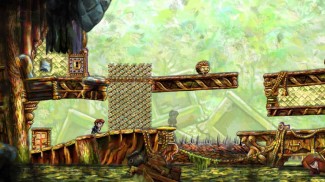Bastion
LQ: 9.15
Recommended Age: 10+
Skills Used: Planning, Working Memory, Mathematics, Reading
Braid is a story-driven puzzle-platformer in which you play as the character Tim, a love-struck young man on a journey to rescue his Princess from an evil knight. Taking control of time itself in order to traverse the game’s puzzling landscapes, Tim must collect puzzle pieces which help guide him ever closer to reaching the Princess. As Tim’s story is unraveled throughout the game, puzzles become more and more difficult to complete, often requiring significant planning and recollection in order to find a solution. Braid‘s story revolves around mature themes like love and relationships, but contains no inappropriate content. Gameplay is challenging, and features minimal cartoon violence. One instance of strong language occurs at the end of the game. Due to these characteristics, Braid is recommended to players ages 9 and up.
Braid is a great educational game for practicing Planning, and Working Memory Skills. We have also identified it as a particularly good choice for children with ADHD. Braid is available for PS3, Xbox 360, PC and Mac.
Recalling and retaining information while working.
In Braid, players must collect multiple puzzle pieces scattered throughout the world by manipulating time. Puzzles require players to complete complex multi-step problems by rewinding time and altering the environment around them. Each world introduces new gameplay mechanics, like the ability to rewind time, objects that are immune to being rewound, and time dilation (the slowing of time). As puzzles become more complex, the player must recall previous actions and the effects they had on the game world, memorizing what's happening in the environment around them and using that information later in the level. f
Developing a systematic approach for setting and achieving goals.

Most puzzle pieces in Braid will not be captured on the player's first attempt, as gathering a puzzle piece requires players to carefully plan their actions before taking even one step. Because each action taken by players commonly happens again, but in reverse, even the smallest movements can alter the flow of time and layout of the world itself. Players must therefore prioritize their actions and carefully determine how to reach their goal. If they do not take the time to brainstorm solutions and think ahead, they will have a very difficult time solving Braid's later puzzles and discovering the story of Tim's past.
 Braid's engaging gameplay and beautifully crafted environments are matched by a deep, somewhat ambiguous story which is revealed in pieces of text introduced to players periodically throughout the journey. Before entering each world players can choose to read several short excerpts from Tim's story. Each world's mechanics reflect the context of these texts, covering topics such as forgiveness, regret, and devotion. Each passage read by will reveal new insights into Tim's troubled past, allowing readers to slowly formulate their own idea of who the characters are and why they are here. After completing Braid and unlocking the epilogue, players will be left to interpret Tim's story their own way.
Braid's engaging gameplay and beautifully crafted environments are matched by a deep, somewhat ambiguous story which is revealed in pieces of text introduced to players periodically throughout the journey. Before entering each world players can choose to read several short excerpts from Tim's story. Each world's mechanics reflect the context of these texts, covering topics such as forgiveness, regret, and devotion. Each passage read by will reveal new insights into Tim's troubled past, allowing readers to slowly formulate their own idea of who the characters are and why they are here. After completing Braid and unlocking the epilogue, players will be left to interpret Tim's story their own way.
 Braid is a game that requires careful planning, and can be a great tool to help children diagnosed with ADHD to exercise thoughtfulness and problem-solving. The ability to recall and apply various bits of in-game information is also needed, as the game's rules and mechanics constantly expand throughout the game. This kind of gameplay helps players practice Working Memory, a skill that can be beneficial for children dealing with the challenges of ADHD to exercise.
Braid is a game that requires careful planning, and can be a great tool to help children diagnosed with ADHD to exercise thoughtfulness and problem-solving. The ability to recall and apply various bits of in-game information is also needed, as the game's rules and mechanics constantly expand throughout the game. This kind of gameplay helps players practice Working Memory, a skill that can be beneficial for children dealing with the challenges of ADHD to exercise.
All membership plans come with full access to our entire suite of tools learning guides, and resources. Here are a few of the ones we think you’ll like the most: